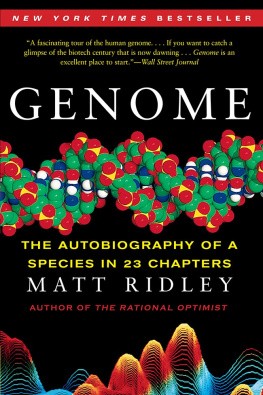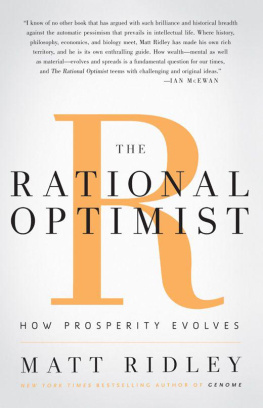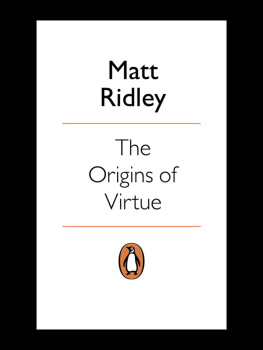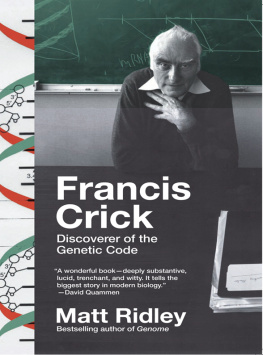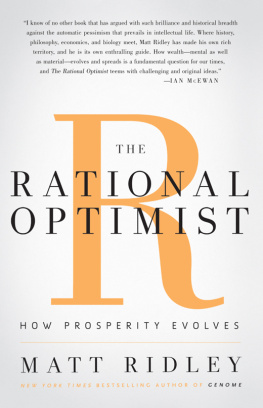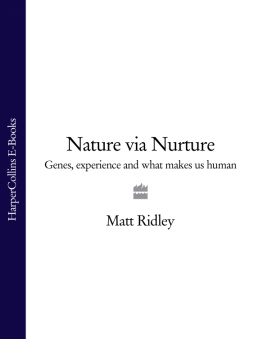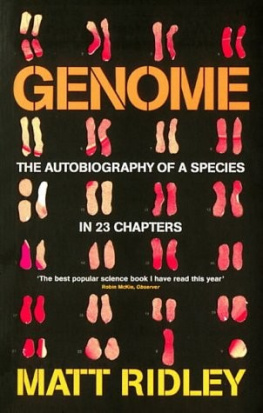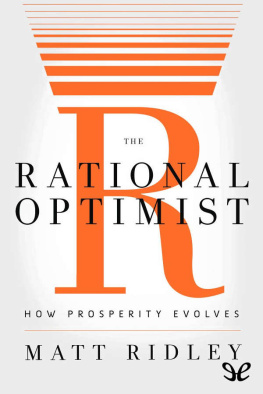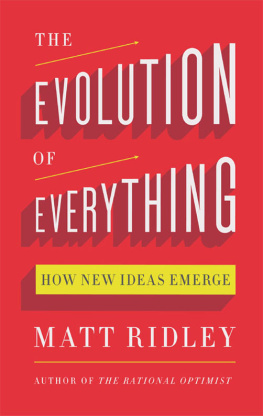Matt Ridley - Genome: The Autobiography of a Species in 23 Chapters
Here you can read online Matt Ridley - Genome: The Autobiography of a Species in 23 Chapters full text of the book (entire story) in english for free. Download pdf and epub, get meaning, cover and reviews about this ebook. year: 2006, publisher: Harper Perennial, genre: Science. Description of the work, (preface) as well as reviews are available. Best literature library LitArk.com created for fans of good reading and offers a wide selection of genres:
Romance novel
Science fiction
Adventure
Detective
Science
History
Home and family
Prose
Art
Politics
Computer
Non-fiction
Religion
Business
Children
Humor
Choose a favorite category and find really read worthwhile books. Enjoy immersion in the world of imagination, feel the emotions of the characters or learn something new for yourself, make an fascinating discovery.
- Book:Genome: The Autobiography of a Species in 23 Chapters
- Author:
- Publisher:Harper Perennial
- Genre:
- Year:2006
- Rating:5 / 5
- Favourites:Add to favourites
- Your mark:
- 100
- 1
- 2
- 3
- 4
- 5
Genome: The Autobiography of a Species in 23 Chapters: summary, description and annotation
We offer to read an annotation, description, summary or preface (depends on what the author of the book "Genome: The Autobiography of a Species in 23 Chapters" wrote himself). If you haven't found the necessary information about the book — write in the comments, we will try to find it.
Genome: The Autobiography of a Species in 23 Chapters — read online for free the complete book (whole text) full work
Below is the text of the book, divided by pages. System saving the place of the last page read, allows you to conveniently read the book "Genome: The Autobiography of a Species in 23 Chapters" online for free, without having to search again every time where you left off. Put a bookmark, and you can go to the page where you finished reading at any time.
Font size:
Interval:
Bookmark:

GENOME
THE AUTOBIOGRAPHY OF A SPECIES IN 23 CHAPTERS
MATT RIDLEY

Contents
When I began to write this book, the human genome was still a largely unexplored landscape. Some eight thousand human genes had already been roughly located, and I mention a few of the most interesting ones in the book, but the rapid acceleration towards the reading of the entire genome still lay in the future. Now, only a little over a year later, that gargantuan task is complete. Scientists all over the world have deciphered the entire human genome, written down its contents and distributed them on the Internet to all who wish to read them. You can now download from the Internet the near-complete instructions for how to build and run a human body.
The revolution was swift. In early 1998, the publicly funded scientists who made up the Human Genome Project still predicted that they would take another seven years at least to read the entire human genome, and they had barely read ten per cent of it by then. Then, suddenly a joker was thrown on the table. Craig Venter, a flamboyant and impatient scientist now working in the private sector, announced that he was forming a company and would do the job by 2001 for a fraction of the cost: less than 200 million.
Venter had made such threats before, and he had a habit of delivering results. In 1991, he had invented a quick way to find human genes when everybody said it could not be done. Then in 1995, he received a withering reply to his request for a government grant to map a whole bacterial genome using a new shotgun technique. The technique would never work, said the officials. The letter arrived when the job was already almost complete.
So it would be a foolish person who bet against Venter a third time. The race was on. The public project was reorganised and refocused; extra funding was poured in and a goal was set to complete a first draft of the entire genome in June 2000. Venter soon set his sights on the same deadline.
On June 26, 2000, President Bill Clinton in the White House and Tony Blair in Downing Street simultaneously announced that the rough draft was complete. This is therefore an astonishing moment in human history: the first time in the story of life on earth that a species has read its own recipe. For the human genome is nothing less than the instructions for how to build and run a human body. Hidden within it, as I have tried to show in the book, lie thousands of genes and millions of other sequences that constitute a treasure trove of philosophical secrets. Most of the research into human genes is driven by the urgent need to find cures for both inherited diseases and the more common diseases like cancer and heart disease, whose origins are abetted or enhanced by genes. A cure for cancer would, we now know, be virtually impossible if we did not understand the role of cancer genes and cancer-suppressing genes in the progress of tumours.
Yet there is much more to genetics than medicine. As I have tried to show, the genome contains secret messages from both the distant and the recent past from when we were single-celled creatures and from when we took up cultural habits such as dairy farming. It also contains clues to ancient philosophical conundrums, not least the question of whether and how our actions are determined and what is this curious sensation called free will.
The completion of the genome project has done little to change this picture, but it is gradually adding more examples to the themes I explore in this book. As I wrote, I was conscious that the world was rapidly changing; genetic knowledge was exploding all about me in the scientific literature. I could do no more than capture the first glimpse of some of these exciting debates. But many great insights still lie in the future. Science, I believe, is the search for new mysteries rather than the cataloguing of old facts. I have little doubt that there will be astounding surprises in store for us over the next few years. We are realising for the first time just how little we know about ourselves.
What I could not have foreseen is how dramatically the debate over genetics would have invaded the public media. With controversy raging over genetically modified organisms and with speculation growing about cloning and genetic engineering, the public is demanding the right to be heard. Quite correctly it does not want these decisions left only to the experts. But most geneticists are too busy mining nuggets of intellectual gold from the laboratory to give up their time to explaining their science to the public. So it falls to commentators like me to try to translate the arcane stories of genes into something more like entertainment than education.
I am an optimist. As will be clear from this book, I think knowledge is a blessing, not a curse. This is especially true in the case of genetic knowledge. To understand the molecular nature of cancer for the first time, to diagnose and prevent Alzheimers disease, to discover the secrets of human history, to reconstruct the organisms that populated the pre-Cambrian seas these seem to me to be immense blessings. It is true that genetics also brings the threat of new dangers - unequal insurance premiums, new forms of germ warfare, unanticipated side effects of genetic engineering - but most of these are either easily dealt with or extremely far-fetched. So I cannot subscribe to the fashionable pessimism about science nor can I warm to the idea of a world that turns its back on science and the unending assault on new forms of ignorance.
The human genome - the complete set of human genes - comes packaged in twenty-three separate pairs of chromosomes. Of these, twenty-two pairs are numbered in approximate order of size, from the largest (number i) to the smallest (number 22), while the remaining pair consists of the sex chromosomes: two large X chromosomes in women, one X and one small Y in men. In size, the X comes between chromosomes 7 and 8, whereas the Y is the smallest.
The number 23 is of no significance. Many species, including our closest relatives among the apes, have more chromosomes, and many have fewer. Nor do genes of similar function and type necessarily cluster on the same chromosome. So a few years ago, leaning over a lap-top computer talking to David Haig, an evolutionary biologist, I was slightly startled to hear him say that chromosome 19 was his favourite chromosome. It has all sorts of mischievous genes on it, he explained. I had never thought of chromosomes as having personalities before. They are, after all, merely arbitrary collections of genes. But Haigs chance remark planted an idea in my head and I could not get it out. Why not try to tell the unfolding story of the human genome, now being discovered in detail for the first time, chromosome by chromosome, by picking a gene from each chromosome to fit the story as it is told? Primo Levi did something similar with the periodic table of the elements in his autobiographical short stories. He related each chapter of his life to an element, one that he had had some contact with during the period he was describing.
I began to think about the human genome as a sort of autobiography in its own right - a record, written in genetish, of all the vicissitudes and inventions that had characterised the history of our species and its ancestors since the very dawn of life. There are genes that have not changed much since the very first single-celled creatures populated the primeval ooze. There are genes that were developed when our ancestors were worm-like. There are genes that must have first appeared when our ancestors were fish. There are genes that exist in their present form only because of recent epidemics of disease. And there are genes that can be used to write the history of human migrations in the last few thousand years. From four billion years ago to just a few hundred years ago, the genome has been a sort of autobiography for our species, recording the important events as they occurred.
Next pageFont size:
Interval:
Bookmark:
Similar books «Genome: The Autobiography of a Species in 23 Chapters»
Look at similar books to Genome: The Autobiography of a Species in 23 Chapters. We have selected literature similar in name and meaning in the hope of providing readers with more options to find new, interesting, not yet read works.
Discussion, reviews of the book Genome: The Autobiography of a Species in 23 Chapters and just readers' own opinions. Leave your comments, write what you think about the work, its meaning or the main characters. Specify what exactly you liked and what you didn't like, and why you think so.

